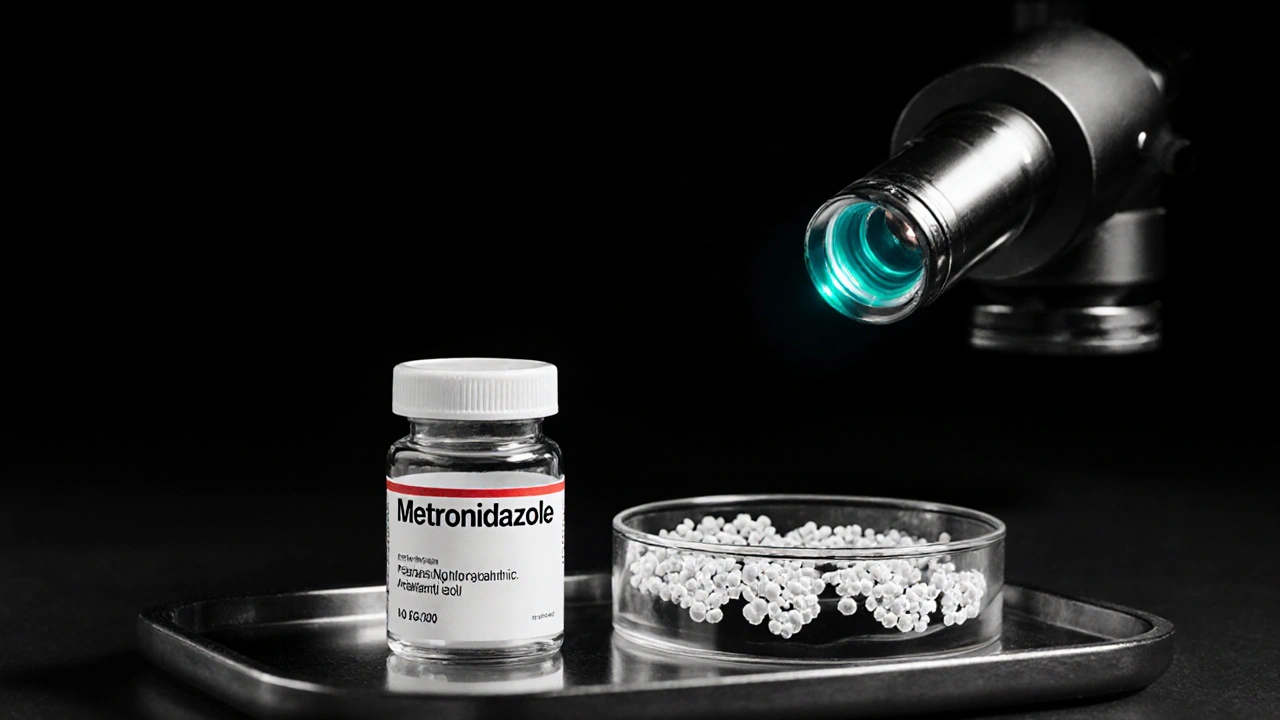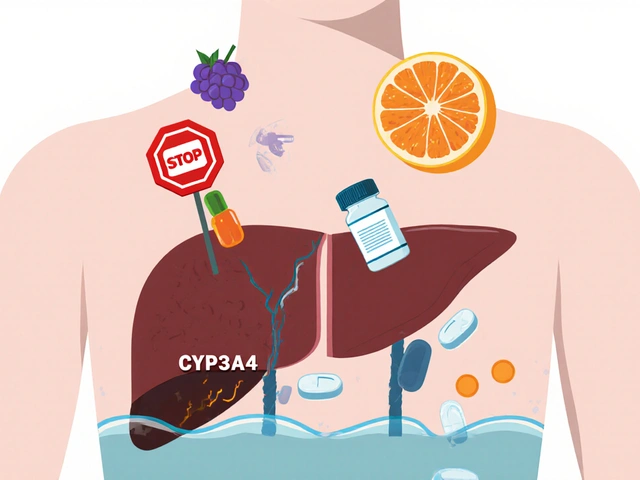Yeast Infection Treatment Guide
This tool helps you determine whether your symptoms suggest a yeast infection or bacterial vaginosis, and what treatment options are appropriate based on your situation. Always consult with a healthcare professional for proper diagnosis and treatment.
Key Takeaways
- Metronidazole is an antibiotic targeting anaerobic bacteria and certain parasites, not yeast.
- Typical yeast infections are caused by Candida albicans (a common fungus that lives on skin and mucous membranes).
- Standard antifungal drugs such as Fluconazole and Clotrimazole are far more effective.
- Using Metronidazole for a yeast infection can delay proper treatment and may worsen symptoms.
- If you suspect a yeast infection, talk to a healthcare professional for a proper diagnosis and targeted therapy.
When you read the headline “Can Metronidazole Treat Yeast Infections?” you probably expect a clear yes‑or‑no answer. The reality is a bit messier, but the short answer is: Metronidazole is not the right drug for a typical yeast infection. Let’s break down why, how yeast infections develop, what medications actually work, and what you should do if you’re unsure.
What Is Metronidazole?
Metronidazole (a nitroimidazole antibiotic that kills anaerobic bacteria and protozoa) has been a staple in clinics since the 1960s. It works by entering microbial cells, disrupting DNA synthesis, and ultimately causing cell death. Doctors commonly prescribe it for bacterial vaginosis, trichomoniasis, and infections caused by Clostridium difficile or Giardia lamblia. Because it targets organisms that thrive without oxygen, Metronidazole is ineffective against aerobic bacteria and, importantly, fungi.
How Do Yeast Infections Happen?
Yeast infections-often called candidiasis-are primarily driven by Candida albicans, a yeast that normally lives in balance with other microbes in the vaginal microbiome. When this balance tips-due to antibiotics, hormonal shifts, diabetes, or a weakened immune system-the yeast can overgrow, causing itching, burning, and a thick white discharge.
The vaginal ecosystem relies on Lactobacillus species to keep pH low and keep Candida in check. Broad‑spectrum antibiotics can wipe out Lactobacillus, creating an opening for yeast to flourish.
Standard Antifungal Treatments
The go‑to drugs for treating a Candida overgrowth are antifungals, not antibiotics. Two of the most common are:
- Fluconazole (an oral azole that inhibits fungal cell membrane synthesis)
- Clotrimazole (a topical imidazole applied as creams or suppositories)
Both target the same pathway that Metronidazole does not-ergosterol production-making them far more effective at clearing yeast.

Can Metronidazole Kill Yeast?
Scientific studies consistently show that Metronidazole has little to no activity against Candida species. In vitro tests reveal MIC (minimum inhibitory concentration) values far above therapeutic levels, meaning the drug would need unrealistic doses to have any antifungal effect.
There are a few niche scenarios where Metronidazole appears in the same prescription as an antifungal. That usually reflects a mixed infection-bacterial vaginosis plus Candida-where the clinician tackles both microbes. Even then, Metronidazole is never the primary agent for the yeast component.
When Might a Doctor Prescribe Metronidazole Near a Yeast Issue?
Some patients present with vague vaginal symptoms that could stem from bacterial vaginosis (BV), trichomoniasis, or a yeast infection. Because the symptoms overlap (discharge, odor, irritation), doctors sometimes start empiric therapy with Metronidazole while awaiting lab results. If the test later confirms Candida, they’ll add an antifungal.
Off‑label use of Metronidazole for “fungal‑like” conditions is not supported by guidelines from the CDC or IDSA. The risk is that a real yeast infection gets delayed treatment, giving the fungus more time to spread.
Side Effects and Risks of Misusing Metronidazole
Common side effects include nausea, metallic taste, and mild headaches. More serious concerns-though rare-are peripheral neuropathy and a disulfiram‑like reaction with alcohol. Using Metronidazole when it’s not needed only adds these risks without therapeutic benefit.
Additionally, unnecessary antibiotic exposure can promote Antibiotic resistance in anaerobic bacteria, indirectly affecting future infection management.

Practical Steps If You Suspect a Yeast Infection
- Track symptoms: itching, burning, thick white discharge, and timing (usually after antibiotic courses).
- Seek a professional evaluation: a simple microscopy or culture can differentiate Candida from bacterial causes.
- If confirmed, use an antifungal-over‑the‑counter clotrimazole cream for mild cases, or a single 150mg oral dose of fluconazole for more persistent infections.
- Avoid douching, scented soaps, and tight synthetic underwear, which can disturb the vaginal microbiome.
- If you’re on antibiotics for another condition, consider probiotic supplements containing Lactobacillus to help restore balance.
Comparison: Metronidazole vs. Common Antifungals
| Drug | Class | Primary Target | Effectiveness for Yeast | Typical Side Effects |
|---|---|---|---|---|
| Metronidazole | Nitroimidazole antibiotic | Anaerobic bacteria, protozoa | None (ineffective) | Nausea, metallic taste, alcohol reaction |
| Fluconazole | Azole antifungal | Candida species | High (gold‑standard oral option) | Headache, liver enzyme elevation |
| Clotrimazole | Imidazole antifungal (topical) | Candida species | High (OTC cream/suppository) | Local irritation, rare allergic rash |
Bottom Line Checklist
- Metronidazole targets bacteria/protozoa, not fungi.
- Candida albicans causes >90% of vaginal yeast infections.
- Use fluconazole or clotrimazole for effective treatment.
- Reserve Metronidazole for confirmed bacterial vaginosis or trichomoniasis.
- Consult a clinician for accurate diagnosis before self‑medicating.
Frequently Asked Questions
Can a single dose of Metronidazole cure a yeast infection?
No. Metronidazole does not act on Candida, so a single dose will not clear a yeast infection. Proper antifungal therapy is required.
Why do doctors sometimes prescribe Metronidazole when I have vaginal symptoms?
Symptoms of bacterial vaginosis, trichomoniasis, and yeast infection overlap. If a clinician suspects a bacterial cause, they may start Metronidazole while waiting for test results, then add an antifungal if Candida is confirmed.
Is it safe to take Metronidazole and an antifungal at the same time?
Generally yes, because the drugs work via different pathways. However, only take both if a healthcare professional has prescribed them for mixed infections.
Can probiotic supplements help prevent yeast infections after antibiotics?
Evidence suggests that Lactobacillus‑based probiotics can aid in restoring vaginal flora, reducing the risk of Candida overgrowth after a course of antibiotics like Metronidazole.
What should I do if I’ve already taken Metronidazole for a suspected yeast infection?
Finish the antibiotic course (to avoid resistance), then schedule a visit with your doctor for proper testing and appropriate antifungal treatment.







Jeff Ceo
October 15, 2025 AT 21:43Enough with the nonsense – slapping metronidazole on a yeast infection is a reckless shortcut that only fuels resistance and delays proper care.
David Bui
November 3, 2025 AT 14:43yeah the article is solid but honestly most people just read the headline and think any pill will fix it it’s not that complicated but they ignore the fact that antibiotics kill good bacteria
Alex V
November 22, 2025 AT 08:43Sure, and while we’re at it, the pharmaceutical overlords are definitely conspiring to hide the "miracle" metronidazole cure from us – oh wait, no, they’re not; it's just basic microbiology, folks. The idea that a drug designed to annihilate anaerobes could magically turn into an antifungal is as laughable as a flat‑Earth theory.
Patrick Nguyen
December 11, 2025 AT 02:43Metronidazole’s mechanism targets bacterial DNA synthesis; fungi lack the requisite pathways, rendering the drug ineffective against Candida.